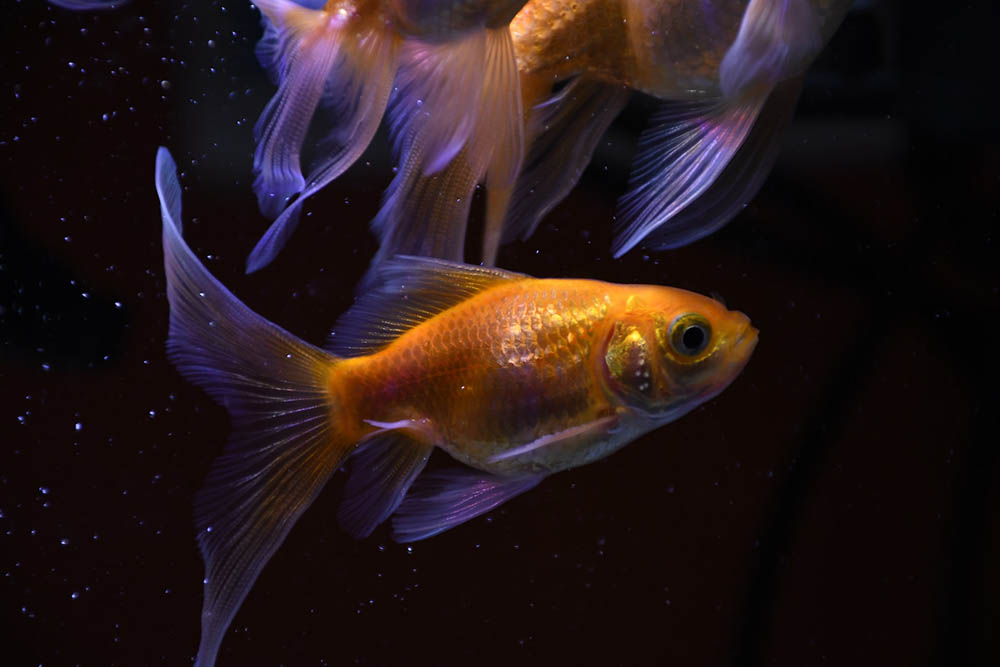Goldfish Water Current: Is Your Filter Too Strong?

Updated on

Today I want to talk about something that often gets overlooked in the hobby.
Water current.
What causes current?
- All electricity-driven filters
- Airstones
- Submersible pumps
So, how much current should goldfish have? I truly believe that for them, the less current—the better. This is interesting (from one of my older books on goldfish):
“One way, the most in use, although the worst for the retail customers, is to keep a steady stream of water constantly flowing through the tank. Now, this is wrong. Goldfish are intended to live in standing water, and should not be made accustomed to the contrary, as the reversing again of the character of the water often proves fatal to them. The proper way to keep fish is in pure standing water, to which the necessary oxygen is supplied by the action of aquatic plants…” (The Goldfish and Its Systematic Culture with a View to Profit,
Now, most pet store fish are born and raised in massive outdoor ponds with practically zero current. They are then shipped to pet stores where they are blasted with strong water currents from mega filter systems and simultaneously exposed to disease. (This obviously is VERY stressful.)
Then they are put in a home fish tank with a power filter and maybe an airstone as well. Some people even add a “wave maker” or underwater pump just to add even more current. Any wonder that so many new fish die in a week just from the shock? While some of the hardier goldfish may adapt to this…
… It may not be ideal.
Many people may tell you that a 10x turnover flow rate is what you want for a filter. While higher flow rates mean more efficient biological filtration, they can mean unhappy goldfish!
Many people say you can never have too much oxygen and filtration and this is usually true. But you CAN have too much current. In the wild, their homes are stagnant ponds. Other fish like the hillstream loach may appreciate more swift-flowing river-like conditions.
Generally, going back to the more natural habitat of the goldfish tends to yield better results for the species. (Obviously keeping fish indoors there is going to be some inevitable difference.)
- If your fish stop swimming, they should not still be moving. Otherwise, they are being blown around.
- If your fish seem to swim in place a bit when getting from point A to point B, it is a sign they are fighting the current
- If your fish sit at the bottom, they may be exhausted from struggling.
Fancy goldfish (especially with long fins) do not appreciate current. The excessive finnage on fancy fish acts like a parachute, catching the water and pushing the fish all around the place. Other experienced goldfish keepers also feel even their slim-bodied fish do much better with lower currents.
- Decreased activity
- Exhaustion
- Stress
- Propensity to illness
- Collapsed fins
Even sponge filters create a significant water current for a goldfish tank. I’m not saying you should never use airstones, filters, or pumps in your aquarium. These things can all be used—but the current should be minimized.
How to Reduce Current
Airstones can be positioned near the surface with a small or adjustable air pump providing a minimal push. (Or an air control valve really helps.) Filter outlets can be placed on the water level and undersized filters used instead of oversized ones (unless you have some way of mitigating the flow, such as using a sump).
Submersible pumps can have the flow rate manually turned down if they are designed to be adjustable, though the more electricity-efficient method would be to get a lower-rated pump.
If you're a new or even experienced goldfish owner who is having issues understanding the intricacies of water filtration, or just wants a bit more detailed information on it, we recommend that you check out our best-selling book, The Truth About Goldfish.
It covers everything about creating the most ideal tank setup and more!
You’d be surprised how much water turnover is really necessary for a good filter to function properly. Especially if you couple it with live plants. Plants are the ultimate low-current water filter.
And not only that, they oxygenate the water as well. In some cases (when properly balanced), plant-only filtration can power an entire tank without the need for an electrical filter altogether. Great for your wallet and your fish.
I mean, an electricity-driven filter may seem less expensive than buying live plants at first. But over time, the energy bills usually dwarf the cost of the filter. In fact, people have been keeping fish for hundreds of years without them. I’m not saying by any means this is the only good way to keep goldfish. Only if you use a mechanical filter that creates current, it’s something that might require a bit of fanangling.
Many fishkeepers have told me that simply reducing the filter current for their fish results in much more active fish – fish that before seemed like they were sick or afraid for no reason.
As always, monitoring the water quality is a good idea when turning down your filters. This makes sure you don’t interrupt your biological cycle, especially with high-turnover reliant filters such as Hang on Back filters. If you find ammonia or nitrite, perhaps consider adding some live plants or a small sponge filter could be just the ticket to a low-current, well-balanced aquarium.

What About Good Circulation?
Some people worry that by reducing the current, you can create “dead spots” in the tank. Lots of water flow ensures no dead spots. Personally? I don’t worry about dead spots. Goldfish themselves constantly move through the water and forage, stirring up the debris on the bottom. This alone seems to be ample activity to prevent dead spots in the water column itself.
Some fishkeepers (myself included) even purposely try to cultivate dead spots in the substrate to help with anaerobic filtration. While this itself is an entirely different subject, my point is that I have yet to see any problems with dead spots. As long as you have a decent amount of plants helping to oxygenate the water? This really shouldn’t be an issue.
Final Thoughts
I’m sure not everyone agrees with me about current, and that there are many people who keep goldfish very successfully in stronger-flow tanks.
This is just what I have found works best for my fish and what I have heard from talking with my readers.
Featured Image Credit: Dobermaraner, Shutterstock












